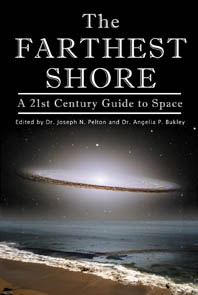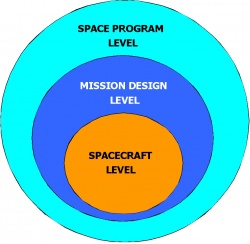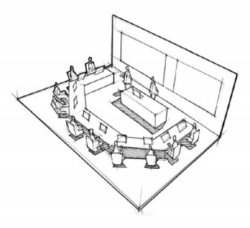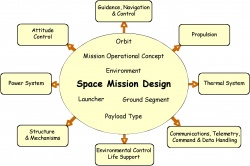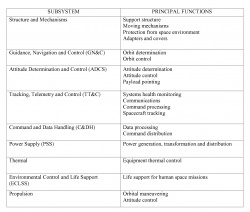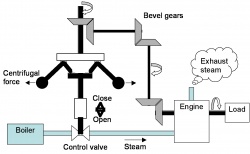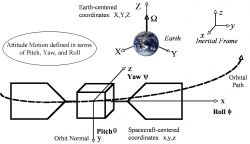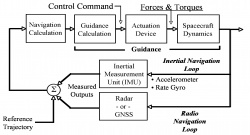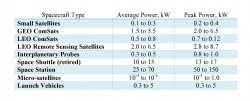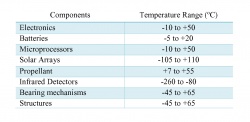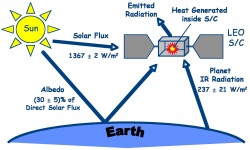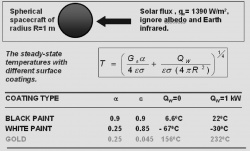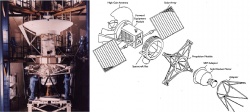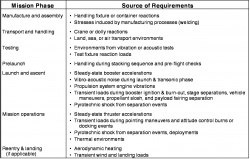The Farthest Shore – Chapter Eight Systems and Spacecraft
From The Space Library
Chapter Eight Systems and Spacecraft
Angie Bukley, John Connolly, Tarik Kaya and Kazuya Yoshida
“Men are weak now, and yet they transform the Earth’s surface. In millions of years their might will increase to the extent that they will change the surface of the Earth, its oceans, the atmosphere, and themselves. They will control the climate and the Solar System just as they control the Earth. They will travel beyond the limits of our planetary system; they will reach other Suns, and use their fresh energy instead of the energy of their dying luminary.” -- Konstantin Tsiolkovsky
Since the dawn of the space age, the exploration of space has been championed as the technological high ground – a perilous environment demanding the best of humankind’s creative talents to explore. Indeed, at first assessment, engineering a spacecraft, or designing a space mission, or architecting an entire space program, appears to be as daunting a feat as any in the realm of human endeavor. Yet no matter how large the problem, skilled engineers have developed methods to break it down into more easily understood parts, and then re-integrate these parts back into a working whole.
Such is the world of complex space “systems.” The seemingly endless number of components that allows us to explore space is just as well defined by their interactions with each other as they are with their standalone characteristics. The result is that the machines and missions of space provide the ultimate “systems” challenge. The engineering pieces of a “space mission” include system elements such as spacecraft subsystems, astrodynamics, launch vehicles and project operations. In this chapter, the most fundamental element of a space mission will be discussed, namely the spacecraft. The spacecraft, be it an Earth orbiting satellite, an interplanetary satellite, or a manned spacecraft, is the most critical aspect of a space mission. But first, let’s discuss systems and the “big picture.”[1] [2]
8.1 The Big Picture – What is a System and Why is That Important?
During the Renaissance and the so-called “Enlightenment,” scientists, doctors, inventors, mathematicians and even philosophers began systematic sharing of their studies and experiments. Royal Academies of Science aided a process of intellectual sharing of research from country to country. This process philosopher Teilhard de Chardin has characterized as the creation of a “noosphere”—a new type of environment where systematic sharing of knowledge and scientific curiosity can truly blossom. But true “systems thinking” is a recent development.
Prior to the mid-1900s, problems of natural science or engineering were still largely viewed as discrete events that could be addressed independently of one another. It was not until the 1940s when Hungarian biologist Ludwig von Bertalanffy and his contemporaries began to apply systems thinking to such diverse fields as physics, biology, psychology, engineering, computing, and management. This way of thinking has become a discipline for seeing the “big picture,” and a framework for seeing broad interrelationships among the pieces of a system rather than a narrow view of the individual piece-parts. About the time that systems thinking was becoming codified as “systems theory” a new era of space exploration began to open as Sputnik was launched in October 1958. Systems theory, a scientific and philosophical approach to studying a complex problem, and space exploration, a complex scientific and engineering problem, were the perfect marriage of problem and solution. Systems theory now permeates our existence and, as a result, the word “system” has become one of the most overused and perhaps abused words in the English language.
8.1.1 Space Systems – A Three-Level Model
There are many models that allow the “deconstruction” of a complex space system into sub-parts of ever-increasing detail. Most of these models are associated with product or work breakdown structures (WBS), and are used to organize the work or hardware products of a particular spacecraft or space mission. Such a breakdown structure might first divide a spacecraft into subsystems (e.g., propulsion, structures, guidance and control, power, etc.), and those subsystems into assemblies (e.g., main solar array assembly), and those assemblies further into components (e.g., a latch mechanism), and so on. These models are useful once a spacecraft or space mission is well defined, but less useful for the initial conceptualization of space systems in the abstract. To view space systems from a “big picture” point of view, we can use a simplified three-level model that addresses the three topmost elements of the space system hierarchy – the spacecraft, the space mission, and the space program architecture.
The model shown in Figure 8.1 is simplified on purpose so that we can use it to discuss the highest levels of space system integration. The core of this model is the spacecraft itself. Though a spacecraft is a complex integration of subsystems, assemblies, and components, this model uses it as the smallest unit of integration in this discussion. A spacecraft, regardless of the precision of its design and craftsmanship, cannot accomplish a mission by itself. The second level of the model, the space mission, combines the spacecraft with the other necessary components, including the launch vehicles, ground infrastructure, mission operations, payload, and the application of astrodynamics that govern the physics of the mission. As with the previous “level”, an expertly designed mission may not ever get beyond the drawing board if not placed within the context of broader space system architecture. The Architecture is the highest level of integration in the three-level model and represents the coordination of a mission with other missions, political pressures, budgets, project schedules, national priorities, and commercial forces. Each of these levels will be explained in greater depth.
†† Unless otherwise indicated, the authors developed the graphics for this chapter.
Each of the levels of the model presented in Figure 8.1 is associated with a “systems” process that involves the breakdown of tasks into ever more precise subtasks and then optimization of each activity. The optimized integration of the spacecraft subsystems (propulsion, structure, communications, etc.) is often referred to as “spacecraft systems engineering”. Designing and assembling a spacecraft is an excellent example of “systems engineering.” This requires the organization of multiple disciplines in a systematic approach to the solution of a complex engineering problem. The term “Space Mission Design” is used to describe the coordination of spacecraft, launch vehicles, ground support systems, planetary physics, and other mission elements. This design process is used to achieve specific scientific or technical goals. Space mission design requires integration of these many diverse components. If done properly the result will be designs that represent the minimum cost and risk. The Program Architecture level of integration in the complex space system model is the coordination of a series of missions with external influences, and falls under such titles as “program management” or “space program architecting”. Each of these integration functions, comprising spacecraft systems engineering, mission design, and program management, are processes used to create integrated solutions to complex problems.
Similarly, the individuals who perform these integration functions are given titles that are employed throughout the industry. At the spacecraft level, the individual who understands the detailed interrelationship among the many subsystems that make up a spacecraft often holds the position of spacecraft “Systems Engineer”. The individual who understands the detailed interrelationship between and among the many vehicle and operational components that make up a mission is often known as the “Mission Designer” or “Mission Engineer”. And at the uppermost level of the hierarchy, the individual who understands the program-level interrelationships, which include missions, politics, national policies, and other factors can occupy any number of important leadership positions, including Program Manager, Administrator, Minister of Space or Space Program Architect. Thus, a team of engineers and program managers combine their experience and “systems skills” to perform the integration function within a space mission.
8.1.2 Spacecraft are the Core of the Three-Level Systems Model
The spacecraft is the core building block in the space systems hierarchy and stands alone as the central element in the three-level space system model in Figure 8.1. It is the fundamental element that ultimately achieves the mission, and it is upon this performance that the mission’s success is judged. Individual spacecraft come in many sizes, ranging from kilogram-sized cubesats, nano, and micro -spacecraft, to refrigerator-size remote sensing satellites, to bus-sized communication satellites and, until relatively recently, aircraft-size space shuttles for transporting human crews and very large payloads. Regardless of size, all spacecraft share common characteristics – a multitude of subsystems. Systems engineers oversee the design and integration of these subsystems to produce a final assembly that performs as a single entity.
Spacecraft are inherently complicated. Their many interacting subsystems require the expertise of an experienced engineer to optimize and integrate the many spacecraft subsystems. This integrator, or Spacecraft Systems Engineer, must be expert in the details of many engineering systems, and must be able to envision how a change to one system will affect all other spacecraft systems. In the vignette below, let’s not worry about the definitions of each of the subsystem components called out in the question. The point is that even though the spacecraft is the core of the three-level systems model, it comprises many smaller subsystems and components. The Systems Engineer must know how all of these things work together and how they are all interrelated.
The Relative Importance of Spacecraft Subsystem
Here’s a simple test to gauge your Spacecraft Systems Engineering aptitude: You are part of a team designing a mission to land on Mars. Which spacecraft subsystem is the most important for this mission: Power? Propulsion? Structure? Communications? Attitude control? Command and Data Handling? Guidance, Navigation, and Control? Thermal? Power? The Payload?
Discussion: The structural engineer is first to speak up and suggests that the structural system is the most important because it has a high mass. He further suggests that some mass can be saved on this mission by flying a lower “g” entry profile through the Martian atmosphere. The Spacecraft Systems Engineer, however, knows that the lower g entry will affect flight path angle, the guidance system, the integrated heating on the entry system’s thermal protection system, the vehicle shape, the placement of communication antennas, and the packaging of the landing vehicle inside the new aero shape, …in short, she recognizes that a single change in one vehicle subsystem can likely affect every other spacecraft subsystem. And she also knows that there is NO single most important subsystem – all are equal and understanding the interaction among them is most important.
“Systems Engineering” is practiced as both a process and as an art. Both are necessary in the production of a spacecraft, but it is critical to know when each should be applied. The process of Systems Engineering is the subject of many textbooks and professional courses, and most often involves numerous sub-processes such as Functional Analysis, Functional Allocation, Interface Definition, Requirements Development, and Technical Performance Measurement.
Each of these sub-processes often results in data products that usually take the form of documents. While it is important to understand the Systems Engineering Process and to produce the paperwork and computer files that methodically document the design process, this process alone will not produce a spacecraft. While the process of Systems Engineering is systematic and concerned with documentation, the art of Systems Engineering is hands-on, interactive and dynamic. This “art” can be compared to a symphony. In this metaphor, a multidisciplinary collection of subsystem and specialty engineers represents the orchestra, and the Spacecraft Systems Engineer can be thought of the conductor that achieves coherence and balance. The Spacecraft Systems Engineer’s job is to artfully lead the team through a creative design process that begins with a set of spacecraft or mission requirements and ends with an “optimized” design for a spacecraft capable of achieving those requirements in the best possible way, at the least cost and the minimum risk.
The creative systems engineering process is helped by using coordinating facilities. These may be known as a “Concurrent Design Center” or many other similar names. This type of facility allows spacecraft team members to collaborate interactively in real-time as the details of the spacecraft design unfold. As a change is made to one subsystem, it is instantly visible to all other members of the concurrent design team, who can update their design in near real-time. Three examples of such a facility are the ESA Concurrent Design Facility at ESTEC in Noordwijk, The Netherlands; the NASA Jet Propulsion Laboratory “Team-X” in Pasadena, California, USA; and the Integrated Design Studio at the NASA Langley Research Center in Hampton, Virginia, USA. These facilities are laid out in a fashion similar to that of the diagram shown in Figure 8.2 [3], and allow a team of co-located engineers and designers to use collaborative software tools to perform rapid design cycles of spacecraft and space missions. Regardless of the facility, the art of systems engineering always requires an experienced systems engineer to guide the team members through the creative process, to mediate disagreement, and to keep the process focused on producing a product that meets its intended requirements with the correct balance of performance, cost and risk.
8.2 Spacecraft Anatomy – What’s in There and How is it Put Together?
A spacecraft can be an Earth-orbiting satellite or a probe sent into deep space within the solar system or beyond. The spacecraft is conceptually divided into two main elements, the “payload” and the “bus.” To distinguish between these two main elements is simple. Think of yourself using the most common method of inter-city public transportation, a bus. A bus takes you where you want to go, provides environmental control like heating and cooling and, when needed, a place for you to sit. The bus also has some crude level of communications to indicate where you are, what stop is coming up next, and so forth. In this simple example, you, as the passenger on the bus, are the payload. From the perspective of you as the payload, the bus exists to get you where you want to be and to cater for your needs while you are onboard. The spacecraft bus exists to provide a “seat” to the payload traveler.
In this case, the “bus” provides the spacecraft payload many things: power, propulsion for movement, environmental control, and communications in the form of data transfer for the payload being carried to the place(s) it needs to be and do so in an efficient way.
We can think about many different kinds of payloads. These include all the space applications services such as discussed in Chapter 6 that generate over US$260 billion in revenues and vital governmental services on planet Earth. These types of payloads include communication and broadcasting systems (think satellite phone or television transmissions), navigation, meteorological monitoring, or remote sensing units equipped with cameras, sensors or radar systems.
Then there are national security and reconnaissance payloads and a variety of different systems for strategic purposes. There are also astronomical observation platforms, like the Hubble Space Telescope or the James Webb Observatory. There are also probes, manned or unmanned, that are designed to explore the solar system or beyond. Many thousands of payloads have now been launched. These range from tiny cubesats to crewed vehicles that have gone to Moon, as well as a series of space laboratories and international space facilities able to sustain astronauts in space for prolonged periods of time.
In all these examples, the cameras, antennas, radar systems, telescopes, laser systems, transmitters, space laboratories, and life support systems all make up the payload. The rest of the satellite is the part called the bus and provides all the power, orbital maneuvering, temperature control, pointing functions, structural support, and anything else that might be required by the payload to perform successfully the tasks that make up a mission.
The elements of the spacecraft that make up the payload and bus are all interrelated and designed based on the mission requirements. The diagram in Figure 8.3 shows the various spacecraft subsystems and their relationship to the design of the space mission. Each of these subsystems will be discussed in the following sections. Don’t worry; we’ll also discuss the orbit, launcher, ground segment, and mission operations concepts as well, in the next chapter. The space environment was covered earlier, as were the various payload types.
A fundamental subsystem that is not explicitly shown in Figure 8.3, however, is the onboard computer system, which controls everything the satellite does. The onboard computer system can be thought of as the “brain” of the satellite because it monitors everything that’s going on in the satellite. In this respect, the on-board computer system is like your central nervous system and its functioning is critical to mission success. It receives a variety of signals and inputs on a continuous basis. When the onboard computer receives messages from the various subsystems, it produces signals and commands that tell them what to do. This is just what your brain does when it tells your hand to reach out and pick up a glass of water or stroke a soft fuzzy puppy.
Table 8.1 is a summary of the spacecraft subsystems and their major functions. Except for subsystems that are associated with human space flight, particularly environmental control and life support systems, these will all be discussed in this chapter.
8.3 The Satellite’s Brain – The Onboard Computer and Its Function
Just as you could not function without your brain, a spacecraft could not successfully function or execute its mission without the onboard computer system. The computer, or computers, onboard a spacecraft control everything it does. (Since the computer, or the brain, is so important there is often redundancy, or back up processors, in case there is a failure.) Examples of functions that the onboard computer executes include generating commands to tell the attitude control system how to point the satellite in the appropriate direction so that the payload collects data. It also sends commands to servomotors to point an antenna in the appropriate direction so that data collected by the payload can be transmitted to a ground station. Further the onboard computer sends commands to heaters to keep a payload or some other subsystems at the appropriate temperature; or a whole host of other functions that require monitoring and management. Basically, the onboard computer system takes care of everything needed to execute the mission plus all the housekeeping functions, like power regulation and thermal management.
Computers and microprocessors are found throughout the spacecraft. These processors control very complicated interrelationships between subsystems and are also reprogrammable, which is handy when something goes wrong and must be fixed, or “reprogrammed,” after a satellite is launched. Virtually all the spacecraft subsystems are linked to the onboard computer via data acquisition and control (DAC) systems and the spacecraft (S/C) data bus. It is via these means that the computer receives data and transmits commands to change things or to execute specific functions.
Next let’s consider the telemetry, tracking and control (TT&C) and command and data handling (C&DH) subsystems also included in Table 8.1 These are two related subsystems that work with the onboard computer. Telemetry is simply data sent to the ground concerning the operation and health of the spacecraft. The data can come from any subsystem, but is typically spacecraft engineering data. The telemetry tells how well is the spacecraft working—or not working. Tracking is the determination of the actual location of the spacecraft in inertial space. Control is simply the operation of the spacecraft through the execution of required functions. The TT&C system may also include a communications system. Its main functions are to: (i) control all the spacecraft subsystems; (ii) process com-mands; (iii) acquire data; (iv) format and store data; and (v) perform ranging. The “master control” computers are part of the TT&C unit.
A command is just an instruction to a subsystem to execute a specific function. A command can be sent from the ground or from an onboard computer. Data handling is the gathering and formatting of data from all the sensors and instruments onboard the spacecraft. The Command and Data Handling (C&DH) system is a relatively recent term added to the jargon of space systems engineering. The existence of such a subsystem implies a separate radio communications subsystem. All the above functions work together in a seamless way to ensure the smooth execution of all satellite function to achieve the mission objectives.
8.4 Staying in Control – How Does the Satellite Know Where It Is, Where It’s Going, and Which Way to Look?
Probably the most complex subsystem on a satellite is the control system. There are many control systems onboard a spacecraft. Let’s focus on the attitude determination and orbital control system. That is the system that determines where the satellite is, where it needs to be, how to get it there, and which way it’s pointing. A vast body of work in automatic control theory has been developed over the years. We are now able to design and build systems, including very complicated satellites that are capable of autonomous operation involving extremely complex tasks. In fact, of all the onboard computers, the guidance and control computer is the “smartest” one! Control theory involves outrageously complicated mathematical relationships and techniques. But let’s start by beginning with a simple system to convey the key concepts and then discuss how these are applied to spacecraft.
The first significant work in automatic control was James Watt’s centrifugal governor for the speed control of a steam engine in the eighteenth century. The basic principle of the Watt’s speed governor is illustrated in the schematic diagram of Figure 8.4. The amount of steam admitted to the engine is adjusted according to the engine speed through the mechanism that uses centrifugal force. The speed governor is adjusted such that, at the desired speed, the amount of steam is just enough to generate the desired speed. If the actual speed drops below the desired value due to disturbance, then the decrease in the centrifugal force of the governor causes the control valve to move downward, supplying more steam, and the speed of engine increases until the desired value is reached. On the other hand, if the actual speed increases above the desired value, then the increase in the centrifugal force of the governor causes the control valve to move upward, decreasing the supply of steam, and the speed of engine decreases until the desired value is reached.
In Watt’s speed governor, feedback control was achieved by the mechanisms using the centrifugal force. Today, those mechanical means are replaced by electrical means, such as sensors (gyros, accelerometers, tachometers, and so on), computers, and motors. However, the principle of the feedback control has never been outdated. Although the sophistication of the sensors, the precision of the mathematics and the fine tuning of thrusters makes attitude control an exact capability, the concepts of using feedback to orient the spacecraft is built on century-old concepts.
8.4.1 Pitch, Yaw and Roll: Angular Momentum
The key to maintaining a satellite in its proper orientation in an X, Y and Z-axis coordinate system, or attitude control, is the proper application of angular momentum. Figure 8.5 illustrates the three-axis reference system that is critical to orienting the payload systems accurately. To work properly, observation cameras, telescopes, broadcast or communications antennas, etc. need to be pointed precisely in three-dimensional inertial space. For spacecraft payloads to provide useful services in space, being precisely oriented to the required pitch, yaw and roll angles is critical.
Finally, there is one other coordinate frame we need to consider, and that is the spacecraft coordinate frame. This frame is the same as any coordinate frame generally associated with a flying vehicle, like an airplane. If you are sitting in an airplane facing forward, the x-axis of that airplane goes straight out the tip of your nose and the nose of the aircraft in the general direction of forward travel. Now, if you raised your right arm and pointed to your right along the direction of the right wing, that direction defines the y-axis. Finally, the z-axis is perpendicular to the x- and y-axes and points straight down toward the ground. The origin can be located at the center of the aircraft, or any other convenient location. In similar fash-ion, we define the spacecraft coordinate frame with the x-axis pointing along the direction of travel in the satellite orbit, the y-axis points in the direction of the “orbit normal” (think of the right wing), where normal also means perpendicular. Finally, the z-axis points towards the center of the Earth. In general, the origin of the spacecraft coordinate frame is located at the center of mass of the spacecraft. The center of mass is the point at which the entire mass of a body may be considered concentrated for some purposes; formally, the point such that the first moment of a physical or geometric object about every line through the point is zero. When an object is supported at its center of mass there is no net torque acting on the body and it will remain in static equilibrium: think about balancing a broomstick on your finger. We can now define the location of the spacecraft center of mass relative to the inertial frame and the Earth-centered frame. We can also define the location of any component or subsystem inside the spacecraft relative to the spacecraft-centered coordinate frame.
Finally, we need to address the concept of angular momentum because that is the principle on which the attitude control of a satellite is based. Now, the moment of inertia is the measure of the tendency of a solid body to resist rotational forces and it is analogous (in relation to linear forces) to mass. A rotational force is called a torque. When you screw or unscrew a light bulb into or out of a socket, or use a screwdriver to insert or remove a screw, you are applying a torque.
Just remember, if a torque is applied for a certain amount of time, then the angular momentum of the body will change in proportion to the applied torque. Another way to express this is to say that, if no torque is applied, the angular momentum of the body will be unchanged . Angular momentum is the primary tool used to accomplish attitude control. To explain how this works let’s undertake a thought experiment. Remove a bicycle wheel from the bicycle and hold it in both hands by the axle. Have a friend spin the wheel hard so that it’s spinning very fast. Now, try to rotate the wheel to the left or right. Do you feel how it resists? Using spinning masses (which we call inertial wheels or momentum wheels) or by spinning the entire spacecraft, or part of it, we can control the direction the spacecraft is pointing by taking advantage of this effect.
8.4.2 Control System Sensors, Algorithms, and Actuator
Controlling the vehicle attitude and orbit requires several specific capabilities. There is first a need for sensors to measure vehicle attitude. Secondly, there must be actuators to apply the torques needed to re-orient the vehicle to a desired attitude. Finally, there need to be control computers equipped with algorithms to carry out the calculations needed to determine how to command the actuators, based on the sensor measurement inputs. There are actually many different kinds of sensors used on spacecraft to make these measurements; here is a list of sensors required for attitude and orbital control. Gyroscopes – These devices sense rotation in three-dimensional space, without relying on the observation of external objects. Classically, a gyroscope consists of a spinning mass, but it also typically includes a “Laser Gyro”. These laser gyros utilize coherent light reflected around a closed path to maintain stability. Gyros require initialization by some other means, as they can only measure changes in orientation from a pre-determined reference point. In addition, all gyro measurements are subject to drift, and can maintain orientation for limited times only, typically tens of hours or less. Horizon Indicator - An optical instrument that detects light from the ‘limb’ of the Earth’s atmosphere, i.e., at the horizon. It can be a scanning or a staring instrument. Infrared sensors are often used because they will work even on the dark side of the Earth. This type of sensor can provide orientation with respect to the Earth in two orthogonal axes. This type of sensor, however, tends to be less precise than sensors based on stellar observation. Orbital Gyrocompasing – This type of sensor operates in a similar way to a terrestrial gyrocompass. The terrestrial gyrocompass uses a pendulum to sense local gravity and respond to the gravitational affect by alignment with the Earth’s spin vector and thus to point North. The orbital gyrocompass uses a “horizon sensor” to sense the direction to Earth’s center, and a gyro to sense rotation about an axis normal to the orbit plane. Thus, the horizon sensor provides pitch (x-axis) and roll (y-axis) measurements, while the gyro pro-vides yaw (z-axis). Sun Sensor – A device that senses the direction to the Sun can be as simple as a collection of solar cells and shades, or as complex as a steerable telescope, depending on the mission requirements for accuracy of pointing and orientation. Star Tracker – A star tracker is a sensitive optical device measuring the direction to one or more stars, using a photocell or solid-state camera to observe the star. There are 57 bright navigational stars in common use; one of the most used is Sirius (the brightest). However, for more complex missions, entire star field databases may be used to identify orientation. One of the risks this entails is that star trackers may become confused by sunlight reflected from the exhaust gasses emitted by thrusters. Controlalgorithms are the computer programs that receive input data from the vehicle sensors and calculate the appropriate torque commands, which are sent to the actuators to rotate the vehicle to the desired attitude. The algorithm can be very simple, e.g., proportional control, a complex nonlinear estimator or many in-between types, depending on mission requirements. Typically, the attitude control algorithms are part of the software running on the hardware that receives commands from the ground and formats vehicle data telemetry for transmission back down.
Just as there many different kinds of sensors onboard the spacecraft, there are also many different kinds of actuators that can be used in attitude and orbit control. Here is a list of some of them.
Thrusters -Thrusters, which are often monopropellant rockets, must be organized as a reaction control system. An array of thrusters provides stabilization torques in all three directions so that the array can control all three axes of roll, pitch, and yaw. The obvious limitation of thrusters is in fuel usage. To keep the spacecraft pointing in the right direction, a tiny blip of thrust is applied in one direction and, a few tens of seconds later, an opposing blip of thrust is needed to keep orientation errors within limits. To minimize fuel limitation on mission duration, auxiliary attitude control systems are used to reduce vehicle rotation to lower levels. These can be smaller, lower thrusts, “Vernier” thrusters that accelerate ionized gases to extreme velocities electrically, using power from solar cells. The key here is that the solar cells provide power that is not exhausted like rocket fuel is.
Spin Stabilization - The entire space vehicle itself can be spun up to stabilize the orientation of a single vehicle axis. This method is widely used to stabilize the final stage of a launch vehicle. The entire spacecraft and an attached solid rocket motor are spun up on what is called a “spin table”. This allows the spacecraft to be rotated along the “thrust axis” by the attitude control system on which the spin table is mounted. When final orbit is achieved, the satellite may be de-spun by various means, or left spinning. Spin stabilization of satellites is only applicable to those missions with a primary axis of orientation that need not change dramatically over the lifetime of the satellite and when there is no need for extremely high precision pointing. It is also useful for missions with instruments that must scan the star field or the Earth’s surface or atmosphere.
Momentum Wheels - These are electric motor driven rotors made to spin in the direction opposite to that required to re-orient the vehicle. Since momentum wheels make up a small fraction of the spacecraft’s mass and are computer controlled, they give precise control. Momentum wheels are generally suspended on magnetic bearings to avoid bearing friction and breakdown problems. To maintain orientation in three-dimensional space, a minimum of two must be used, with additional units providing single failure protection.
Control Moment Gyros (CGMs) - These are rotors spun at constant speed, mounted on gimbals to provide attitude control. While a CMG provides control about the two axes orthogonal to the gyro spin axis, three-axis control still requires two units. This type of gyro is a bit more expensive in terms of cost and mass, since gimbals and their drive motors must be provided. The maximum torque (but not the maximum angular momentum change) exerted by such a gyro is greater than for a momentum wheel, making it better suited to large spacecraft. A major drawback is the additional complexity, which increases the number of possible failure modes.
Solar Sails - These thrust as a reaction force induced by reflecting incident light, and may be used to make small attitude control and velocity adjustments. This application can save large amounts of fuel on long-duration mission by producing control moments without fuel expenditure. Pioneer 10 is an example of this. Large communications satellites with large solar arrays can supplement their stabilization in this manner as well.
Gravity Gradient Stabilization - In orbit, a spacecraft with one axis much longer than the other two, or a long skinny spacecraft, will spontaneously orient itself so that its long axis points at the planet’s center of mass. This system has the virtue of needing no active control system or fuel for orientation. The upper end of the vehicle feels less gravitational pull than the lower end. This provides a restoring torque whenever the long axis is not pointing in the direction of gravitational pull. Unless some means of damping is provided, the spacecraft will tend to oscillate about the axis of gravitation pull. Sometimes tethers are used to connect two parts of a satellite, to increase the stabilizing torque.
Magnetic Torquers – These devices are permanent magnets. They exert a moment against the local magnetic field, so this method works only where there is a magnetic field (such as the Earth’s) to react against. Such a conductive tether can also generate electrical power, at the expense of orbital decay. Conversely, by inducing a counter-current, using solar cell power, the orbit may be raised.
Pure Passive Attitude Control -Gravity gradient and magnetic field pointing can be combined to form a completely passive attitude control system. Such a simple system has limited pointing accuracy, because the spacecraft will oscillate around the center axis of the attractive force or forces. This drawback can be at least partially overcome by adding a viscous damper. This can be a small can or tank of fluid mounted in the spacecraft, possibly with internal baffles to increase internal friction.
8.4.3 Reaction Control System
A reaction control system (RCS) is another key spacecraft subsystem that is composed of an array of thrusters. As noted above its purpose is to provide attitude control and steering; it can be thought of as just another actuator. An RCS is a system of thrusting actuators, typically working in pairs, that are turned on and off by the attitude or orbital control system. A reaction control system can provide a small amount of thrust in any desired direction or combination of directions. It is also capable of providing torque to control the rotation (roll, pitch, and yaw). This is in contrast to the spacecraft main engine, which provides thrust in one direction, but is much more powerful, and is used for orbital control such as changing orbits or shifting a geosynchronous communications satellite from one region to another.
Typically, these systems use combinations of large and smaller (vernier) thrusters, to allow different levels of response from the combination of different sized thrusters. Reaction control systems are used for
- Attitude control during re-entry
- Station-keeping in orbit
- Close maneuvering during docking procedure
- Control of orientation, or ‘pointing the nose’, of the spacecraft
- As a backup means of de-orbiting.
Such a control system can be incorporated into the payload stage and each of the stages of a multiple stage vehicle. In some missions and designs a reaction control system is built into only the uppermost stage. In this type of design, the RCS operates throughout the flight and provides the control torques and forces for all the stages. Liquid propellant rocket engines with multiple thrusters are most frequently used, not only on launch vehicles but also on the great majority of spacecraft. Cold gas systems were used in early spacecraft designs. Solid fueled apogee kick motors were used in the early generations of communications satellites as well. More recently, electrical propulsion systems have been more widely used, primarily on application spacecraft with extended lifetimes of 15 years or even more. The life of a reaction control system may be short (when used on an individual vehicle stage), or it may see use throughout the mission with a lifetime of many years when part of an orbiting spacecraft.
These control systems can be characterized in many ways. Payload control systems may be described by the magnitude of the total impulse, the number of thrusters, their thrust level, and the directionality of the thrusters, and by their duty cycles. The duty cycle refers to the number of thrust pulses, their operating times, the times between thrust applications, and the timing of these short operations during the mission. For a given thruster, a 30% duty cycle means an average active cumulative thrust period of 30% during the propulsion system’s flight duration. These propulsion parameters can be determined from the mission requirements. Thus, the mission plan will spell out the guidance and control approach. This usually specifies such things as: (i) the desired accuracy, (ii) flight stability, (iii) the likely thrust misalignments of the main propulsion systems, (iv) three-dimensional flight path variations, and (v) the perturbations to the trajectory. Some of these parameters are often difficult to determine so some margin must be provided against contingencies.
8.4.4 Attitude and Orbital Control
Attitude control is the control of the orientation of a spacecraft, or other flight vehicle, either relative to the celestial sphere or to a gravitational body influencing its flight path, like the Earth. The vehicle attitude must be controlled about the three mutually perpendicular axes in a coordinate frame, each with two degrees of freedom (clockwise and counterclockwise rotation), giving a total of six degrees of rotational freedom. These six degrees of rotational freedom are as follows. First there are pitch torques that can raise or lower the nose of the vehicle (i.e. the y-axis). Second there are yaw torques that can induce a motion to the right or the left side (i.e. the z-axis). Third, the roll torques rotate the vehicle (i.e. about its x-axis), either clockwise or counterclockwise.
To apply a true torque, it is necessary to use two thrust chambers of exactly equal thrust and equal start and stop times, placed an equal distance from the center of mass firing in opposite directions. A minimum of 12 thrusters is needed in this system, but some spacecraft with geometrical or other limitations on the placement of these nozzles or with provisions for redundancy may have more than 12. The same system can, by operating a different set of nozzles, create different rotational effects. With clever design it is possible to use fewer thrusters.
Orbital control comprises two main functions, namely navigation and guidance . Navigation answers the question “where am I?” and guidance answers the question “where am I going?” The navigation function determines the actual position and velocity. The guidance function computes the commands to the thrusters required to send the vehicle to the desired location. Figure 8.6 helps to explain the basics of orbital control. By now you have figured out that engineers can’t do anything without a picture!
In an attempt to control a spacecraft, we always begin with a reference trajectory. This reference model is either stored in the memory of the onboard computer or up-linked from controllers (people) on the ground. The reference signal is compared to the sum of the measurements of the vehicle position, velocity, and acceleration. This data when taken together tells you were the spacecraft is located in inertial space and a guidance calculation algorithm calculates what has to be done to get the spacecraft where it needs to go.
Once the calculations are complete, the algorithm then generates commands that drive the actuation devices (thrusters for orbital control) so that the spacecraft can get to where it wants to be. After the appropriate thrust is applied further calculations are made to determine if fine-tuning is necessary to make small corrections.
It is important to note in Figure 8.6 that there are two navigation loops. One is based on measurements made onboard the spacecraft, called the internal navigation loop, and the other is typically based on radar measurements taken from the ground and transmitted to the spacecraft. More recently, global navigation satellite systems, like GPS, have been used to replace the “radio navigation loop,” so that all measurements, as well as verification measurements, can possibly be made onboard the spacecraft. However, care must be taken when using onboard GPS systems because of the rapidly changing GPS satellite positions relative to the spacecraft itself. Further, because the GPS is designed to determine locations at or relatively near the Earth’s surface, some allowances for measurement inaccuracies must be made as well.
8.5 Power Up – Spacecraft Power Sources, Regulation, Distribu-tion and Storage
There are no electrical outlets on a spacecraft - imagine the length of the extension cord required to provide power to an orbiting spacecraft! So, all power requirements onboard the spacecraft must be met by onboard power subsystems. The main functions of the power subsystem are listed below.
- Generate the required power to the spacecraft for the duration of the mission
- Regulate and distribute the power to all subsystems/users onboard the spacecraft
- Support power requirements for average and peak electrical load
- Provide transformation from DC to AC, if required
- Protect against power supply faults or surges.
The mission requirements dictate the necessary performance of a reliable and safe power subsystem, including power levels, frequency, voltage, and capacity. The mission lifetime imposes another requirement on the power supply system in terms of acceptable power degradation over time. How much can the level of power that the power supply system provides degrade over the life of the mission and still do what’s necessary? Mission constraints on the power subsystem include mass, size and volume, cost, schedule, and testability and repair possibilities, which are few on orbit!
Over the lifetime of a mission, the power levels required will vary. It takes much more power to move a pointing instrument, like a telescope on a gimbal, for example, than it does just to collect the data from the instrument without moving it. Typical power levels, N, that are required vary as a function of flight time. The peak power is the maximum power required, which the power supply must provide. Over the course of the mission, the average power is exactly that – the average of the power levels used over the course of the flight. Power is supplied by the spacecraft primary power source, such as a photovoltaic (solar array) subsystem. A secondary power source, such as a battery, provides extra power when needed and compensates during times of peak power consumption. The battery system is particularly critical if the spacecraft spends some of the time in eclipse, behind the Earth from the Sun where solar cells cannot generate any power. Table 8.2 provides typical average and peak power requirements for various spacecraft. There are three energy sources used to generate power onboard spacecraft. These are solar, nuclear, and chemical. Solar power is generated using photovoltaic solar cells (e.g., made of silicon) that convert sunlight into electricity. Solar energy in the form of heat can also be used in solar dynamic systems. Nuclear reactors have also been used on spacecraft, as have systems that convert the energy released by radioactive isotopes into electric power. Chemical power systems comprise the familiar battery system, as well as fuel cells.
The traditional spacecraft power system consists of a solar voltaic generator, incorporating solar panels to collect and convert the solar energy; chemical batteries; and the power regulation, control, and distribution system. The solar generator is sized for the average power output requirement, with a little extra added for safety, deterioration of performance over the spacecraft’s flight time and for battery charging. The solar generator may comprise several solar arrays. Solar array performance is generally characterized by a quantity called efficiency, which is the ratio of the power in (from the Sun) divided by the power out (power produced). Typical efficiencies are 10-25%, but newer technologies using gallium arsenide materials and more junctions, especially in the ultraviolet, can exceed these levels. Solar arrays are either fixed to the spacecraft surface or to Sun-pointing flat panels, which are deployed once the spacecraft is on-orbit. It is also possible to add reflectors so that the solar cells “see” the equivalent of two or even three Suns.
The batteries, a chemical power source, provide a secondary power source that can be used during times of eclipse and to meet peak power requirements. Batteries convert chemical energy into electrical energy and are also characterized by efficiency. For batteries, the efficiency is the ratio of battery electrical capacity (in watts x hours) divided by the mass (in kilograms). Rechargeable batteries are typically nickel-cadmium, nickel-hydrogen, sodium-sulfur, silver-zinc, or lithium-ion. Another type of chemical power source, typically used for human spaceflight, is a fuel cell.
Fuel cells work at low temperatures and generate power based on the reaction between hydrogen and oxygen. They have high energy densities, but are very expensive.
Finally, for a classical spacecraft power subsystem, the power regulator ensures that all the power subsystems are working correctly, controls battery charging and discharging, and the dumping of excess power. While the power generation devices are the main part of the power subsystem, other components responsible for power processing and power distribution (cables, fault protection, power switches, DC to AC converters, and voltage transformers) add up to 30 to 45% of the power subsystem mass!
As a final thought to about our earlier comment about there being no unimportant subsystem, aerospace corporations often put their most experienced engineers on what are perceived to be the most difficult and challenging parts of the mission, and their junior counterparts on the “routine” parts of the program. In actual practice, it turns out that the more “mundane” subsystems in the program can lead to spacecraft failure. In the Intelsat 5 program, defects in the DC to AC power converters led to a satellite failure. Because one of the most common failures in spacecraft relates to power systems, special care must be given to the design and manufacture of these systems.
8.6 Keeping Cool and Staying Warm – Spacecraft Thermal Control
Another key subsystem on the spacecraft is thermal control. [4] [5] The space environment is harsh and temperatures vary from very hot to very, very cold. Considering that almost all instruments and electronics are designed to work at “room temperature” (where humans are quite comfortable working!), it’s no wonder that thermal control is very important to keep everything on the spacecraft working right.
8.6.1 Is Outer Space Hot?
Space can be extremely hot and harmful if you are facing toward the unfiltered radiation of the Sun, and extremely cold if you are facing away from the Sun. As a spacecraft moves around a planet, it will go through eclipses. Therefore, the temperature experienced by the spacecraft will vary from very hot to extreme cold. This further complicates the thermal control of the spacecraft because we would like to maintain the spacecraft and its components within a reasonable range of temperatures.
Many of the spacecraft components are very sensitive to the temperature. Some of these components will not operate, or their performance will be significantly reduced if the temperature operating range is not maintained. Even worse, some components can literally be destroyed, or cease to function, when very hot or very cold. Although the main problem of the thermal engineer is to get rid of the excess heat, some components such as batteries may need to be kept warm to stay operational. Infrared cameras need to be kept cold to increase their sensitivity. Table 8.3 provides typical operating temperature ranges.
Now let’s discuss the thermal environment for a spacecraft in Earth orbit. Figure 8.7 shows that thermal energy from the Sun is transferred to the spacecraft by radiation. There are three modes of heat transfer: conduction, convection, and radiation. In conduction, heat flows from one point to another at a lower temperature through a medium (e.g., two metal blocks put in thermal contact). In convection, heat flows by means of a fluid medium flowing past the heat source (e.g., boiling water in a kettle). Finally, radiation is characterized by the transfer of energy by means of electromagnetic waves emitted by a hot body. This mode does not require a medium to propagate; solar energy arriving on Earth has traveled through the vacuum of space.
On Earth, we experience other modes of heat transfer in addition to radiative heat transfer. The spacecraft will also be heated by albedo radiation, the solar radiation reflected by the Earth, about 30% of the incoming solar radiation. The Earth is itself a source of radiation that contributes to the spacecraft heating. The heat produced by electronic components will further heat the spacecraft. You can now understand why thermal engineers are mostly concerned with rejecting excess heat from LEO spacecraft.
8.6.2. Thermal Equilibrium
If two bodies at different temperatures are brought into thermal contact with each other, they will eventually reach the same temperature. The two bodies come into what we call “thermal equilibrium”. An intuitive concept that we observe operating in daily life is the basis of one of the fundamental laws of thermodynamics. It is possible to determine the thermal equilibrium temperature of a spacecraft in orbit by using basic physical laws, and knowing that the incoming radiation to an object can be absorbed, reflected or transmitted.
Figure 8.8 shows the equilibrium temperature, T, of a spacecraft that is assumed to be a uniform sphere with a radius of one meter. For this example, the solar constant is taken to be 1390 W/m2(typical during northern hemisphere winter). The influence of the coating materials of the spacecraft is significant; the external materials, particularly their absorptivity (α) and their emissivity (ε) as determined by their color, are extremely important. In Figure 8.8, Gs is the heat generated inside the spacecraft, Qw is the energy input to the satellite, and σ is the Stefan-Boltzmann constant; this Figure not only indicates how to create the correct thermal budget for a spacecraft but it also provides a useful hint for you to choose the right surface properties such as color for your clothing when the seasons change. White is the best for hot summer days, and gold will keep you very warm!
It seems that it is quite straightforward to manage the spacecraft temperatures by choosing the right external surface. Actually, the problem is much more complex due to the varying heat input and output. As the spacecraft goes around in its orbit, it goes in and out of eclipse and its orientation to the Sun will change. This will bring temperature variations with respect to time and major temperature gradients in the spacecraft itself. In addition, the spacecraft is unlikely to be a perfect sphere; its complex geometry must be considered to make accurate predictions of the temperature distributions around the spacecraft. There are several software packages to tackle such a complex problem, the well-known ones including those named SINDA, TMG, and ESATAN.
8.6.3. Thermal Control Hardware
At this point, it should be clear to you that the thermal engineer’s simplest tool is choosing the appropriate coating or spacecraft surface finishes.[6] This is essentially what we do before leaving our home to go to work, depending on the weather conditions. Coatings and surface finishes are passive systems; they have no moving parts, nor do they require any power to operate. Engineers love passive systems since they do not require maintenance, and they are more reliable than the alternative active systems. Therefore, a thermal engineer first tries to solve the thermal design problems using passive systems. If that doesn’t work, she must try using active systems. It is common that passive and active systems are used together.
8.6.3.1 Passive Thermal Control Hardware
Multi-Layer Insulation. Multi-layer insulation (MLI) is frequently used in spacecraft to minimize the heat exchange of a component with other components or with space. A typical MLI has 20-25 layers per centimeter of blanket thickness. Mylar or kapton sheets with aluminized surfaces are widely used in this way. Several layers increase the thermal resistance to radiation, generating a very low effective emissivity for the MLI blanket. The layers may be separated by a nylon net to decrease the thermal conductance. MLI insulation gives the spacecraft its shiny appearance. It is often used to insulate sensitive components, such as cameras, to minimize thermal gradients.
Coatings and Paints. There are several coatings and paints available with varying reflectivity values. The thermal engineer chooses a combination of these materials to manage the temperature of a spacecraft. One important consideration is the degradation of these surfaces during the mission life, but this can be predicted. The thermal engineer often introduces some additional margin in the design to make sure that the surfaces con-tinue to be effective until the end of the mission. Well-known coatings include Second Surface Mirrors (SSM) and Optical Solar Reflectors (OSR). The general principle is that the surface should reflect the incoming solar energy with low absorptivity. It should emit the absorbed energy as infrared radiation, with high emissivity.
Heat Pipes. Heat pipes have been effective tools for the spacecraft thermal control since the 1980s. The operational principle of a heat pipe is based on the capillary forces produced in a wick structure. As shown in Figure 8.9, the working fluid in a heat pipe, usually ammonia saturates the wick. When the heat is applied to one end, the working fluid evaporates and the vapor so formed is pushed to the other end of the heat pipe. This end is connected to a radiator, or a cold sink, where the working fluid condenses. The condensate is finally brought back to the evaporation section because of the capillary forces generated inside the wick structure. Heat pipe operation is passive and the thermal conductivity is very high. Therefore, heat pipes have been extensively used for more demanding thermal control challenges, and are still being improved. Specific applications of heat pipes include diode heat pipes, variable conductance heat pipes, and oscillating heat pipes. Newer versions of heat pipes, e.g., loop heat pipes, are being used more and more in space industry. They can handle higher heat loads, up to kilowatts. Although heat pipes are very sensitive to gravity and do not operate at adverse tilts (i.e. where the evaporator is above the condenser), these new design heat pipes can operate against gravity. This is a very important feature to note when testing the spacecraft on the ground.
8.6.3.2 Active Thermal Control Hardware
Heaters . Heaters in the form of a film resistance are widely used in a spacecraft to maintain a component at a desired temperature. A general approach is to keep the component temperatures low by using passive techniques and to control the temperature within a narrower range using heaters controlled by thermostats. As these have moving parts and require power from the spacecraft, this type of thermal control system is clearly an active system that adds weight and drains energy. Although the thermal engineer, for these reasons, prefers passive systems, there are cases where it is impossible to accomplish the performance required without using some active thermal control hardware.
Thermoelectric Coolers. Thermoelectric coolers are based on the so-called Peltier Effect. Here an electric current passing through a semiconductor removes heat from a component towards another heat sink. Thermoelectric coolers are used for fine temperature control of smaller components. Their lifetime and structural integrity can be problematic for some space missions; however, they have been used successfully in several space missions.
Louvers . Louvers are a mechanical means of changing the surface properties by exposing different reflectivity values, depending on the position of movable external surfaces. Think of these devices like the louvered blinds on your window. You open them to let light in, close them to keep light out. The reflectivity is high when the external surface is closed. If these surfaces are exposed to solar illumination and the temperature increases above some desired level, the external surfaces open.
Open and Closed Loop Systems. If the thermal control requirements for a mission are very demanding, such as very low temperatures or high heat loads, the thermal engineer must consider more sophisticated methods; sometimes these are heavier, less reliable and more expensive in terms of complexity. An open loop system is an expendable cooling method, normally used when temperatures below -70oC are required. With these types of systems, a certain amount of liquid (helium or ammonia) is carried in a tank within the spacecraft. This liquid absorbs the heat from a spacecraft component such as an infrared camera; the heated gas is then vented to space. When the cooling liquid is exhausted, the mission obviously comes to an end. The Space Infrared Telescope Facility (SIRTF) carried a tank of 360 liters of liquid helium to maintain the camera temperature at 5.5K.
Closed loop systems in many ways resemble a home refrigerator. A cooling liquid is circulated by a pump, the cooled part being attached to an evaporator (the cooling compartment of your refrigerator). The heat rejection part is attached to the spacecraft radiator (the external condenser of your refrigerator). Crewed space vehicles, such as the Space Shuttle and the International Space Station are two examples of where closed loop cooling systems are used. These systems can handle large heat loads; they also have other advantages, such as better control for varying mission requirements. However, they are heavier, more complex, more expensive, and less reliable due to the various moving parts in active systems.
8.7 Keeping it all Together – Spacecraft Structure
We’ve covered almost all the main subsystems that together form a spacecraft. Now we discuss the elements of the spacecraft that hold everything together – the structural components. The spacecraft structure provides the mechanical support to all the subsystems within the spacecraft (and the launch system). This support must be provided from the time that manufacturing begins until the end of the mission. We define the primary structure as the load-carrying part of the structure. The primary structure is the spacecraft frame, or skeleton, and functions much like the large bones in your skeleton – your legs, hips, and backbone – supporting your weight. Examples of primary structures in a spacecraft include the thrust cone and cylinders, support bulkheads, longerons, launch vehicle adapters, and propellant tanks. We define secondary structures as the non-load carrying parts. Secondary structures comprise brackets, panels, and deployable items like antennas and solar panels. Secondary structures are not as massive as primary structures, in general.
There are different kinds of structures found on a spacecraft. These include skin panel assemblies, trusses, ring frames, fittings and brackets, pressure vessels, component boxes, and deployable structures like solar arrays, astromasts, and antennas. Can you identify the different kinds of structures used in the Magellan spacecraft, shown in Figure 8.10? Which are primary structures? Which are secondary structures?
There are three main properties which characterize structures, namely their strength, stiffness and stability , all three of which play a key role in how spacecraft structures are designed. Strength is defined as the amount of load a structure can carry without experiencing either complete failure or sufficient deformation to jeopardize the mission. Stiffness is a measure of the load required to cause a given deflection. And stability is the ability of a structure to maintain its configuration within a certain tolerance to support the correct orientation of the payloads or subsystems. Stability is the ability of a structure to resist buckling. Buckling is the phenomenon that happens when the structure collapses. A good way to demonstrate buckling is to stand an empty soda can on the floor (flat end on the floor) and then carefully try to stand on it. When the soda can collapses under your weight – that’s buckling! A structure is sized by the largest of the strength, stiffness, and stability requirements.
Other structural properties can be defined as well. The structural life is the number of loading cycles a structure can withstand before it fails, or the duration of a sustained load that a structure can withstand until its materials fail. Damping is a characteristic inherent to the structural material, and refers to the dissipation of energy during vibration. Without damping, an excited structure would continue to vibrate forever.
Structural requirements are derived from all the environments in which the structure must function, including ground, launch, and space environments. Each of these environments imposes their own requirements. The structural elements of a spacecraft must retain their integrity after exposure to these environmental conditions with minimum mass, minimum cost, and maximum reliability. No small task, this! During launch, the spacecraft structural requirements are dictated by the launch vehicle, which creates major mechanical loads at liftoff, including thrust, acceleration, acoustic noise, and shock. The launch environment is generally the main spacecraft structural design driver. During launch, the spacecraft is subjected to:
- Low-frequency sinusoidal vibration that is generated by aero dynamic forces acting on the launch vehicle, and transient events like staging, fairing jettison, and engine cutoff,
- High-frequency random vibration that is produced by mechanical parts in motion like engine turbo-pumps, fuel combustion, and structural elements excited by acoustic noise,
- Acoustic noise that is reflected off the ground and pad facilities at liftoff and peaks with the maximum dynamic pressure being experienced during ascent, and
- Shock that occurs during pyrotechnic events such as booster separation, staging, fairing jettison, and spacecraft separation.
During the launch phase, structural strength and stability are the most important! Table 8.4 summarizes structural requirements by mission phase. When the spacecraft is in orbit, the internal components, i.e. all the subsystems we’ve discussed so far, dictate the structural requirements. On-orbit mechanical loads are substantially smaller in magnitude. Vibration is the main problem when the spacecraft is in orbit. Examples of vibration sources include payload pointing and slewing, turbine-driven machinery, thrusters, cryogenic coolers, and even the motion of the crew. Vibrations are transmitted through the structure; therefore, structural stiffness, or resistance to deflection, is the most important characteristic. Structures vibrate at their natural frequencies, which are the frequencies at which the structure vibrates when excited by a given transient load and then allowed to move freely. The fundamental frequency of a structure is the lowest natural frequency.
Something design engineers strive to avoid is structural resonance , which is the condition in which an object experiences large amplitude vibrations in response to an external stimulus acting at or near a natural frequency of an object. The natural frequencies of spacecraft structural elements must be kept separated to avoid resonant coupling caused by excitations from vibrating sources and with the control system. Otherwise, catastrophic situations can occur.
Spacecraft structures, and all spacecraft components and subsystems, undergo rigorous testing procedures at every step of the fabrication process. Examples of the kinds of tests include vibration, acoustic, shock, vacuum and thermal cycling, and mechanical cycling tests. There are a host of other tests that can be reviewed on the web page accompanying this book. Of paramount importance in all testing is the development of a detailed and thorough test plan. At a minimum, a test plan includes the following elements.
- Test objective
- Test methodology or protocol
- Step-by-step procedural detail
- Test equipment required
- Input/output value limit
- Expected result
- Pass/fail criteria.
Following the test plan faithfully is crucial to ensure accurate results and to protect expensive hardware!
8.8 Designing a Spacecraft
A popular television commercial made by the Holiday Inn hotel chain claimed that, if staying at one of their hotels is “smart”, then merely staying there one night will make you an expert on virtually any subject— from being a doctor to a rocket scientist. We do not expect you to be able to design and build a spacecraft from reading this chapter, nor to have mastered the systems design skills to know how to optimize the design. We do hope however that you now understand the major components or subsystems and their overall importance to making the spacecraft work in such a way as to fulfill the mission requirements.
Footnotes
- ^ J. Wertz, D. Everett, and J. Puschell, Space Mission Engineering: The New SMAD, 1st edition, Space Technology Library, 2011.
- ^ W. J. Larson and L. K. Pranke (eds.), Human Space Flight: Mission Analysis and Design, McGraw-Hill, 1999
- ^ See http://www.j-cds.nl/index.php?site=solutions&search=alle&block_id=66
- ^ J. Wertz, D. Everett, and J. Puschell, Space Mission Engineering: The New SMAD, 1st edition, Space Technology Library, 2011.
- ^ D. G. Gilmore, Spacecraft Thermal Control Handbook: Fundamental Technologies, 2nd edition, Aerospace Press, 2002.
- ^ P. Fortescue, J. Stark, and G. Swinerd, Spacecraft Systems Engineering, 3rd edition, 2003
The Farthest Shore – Chapter Nine Space Missions and Programs
